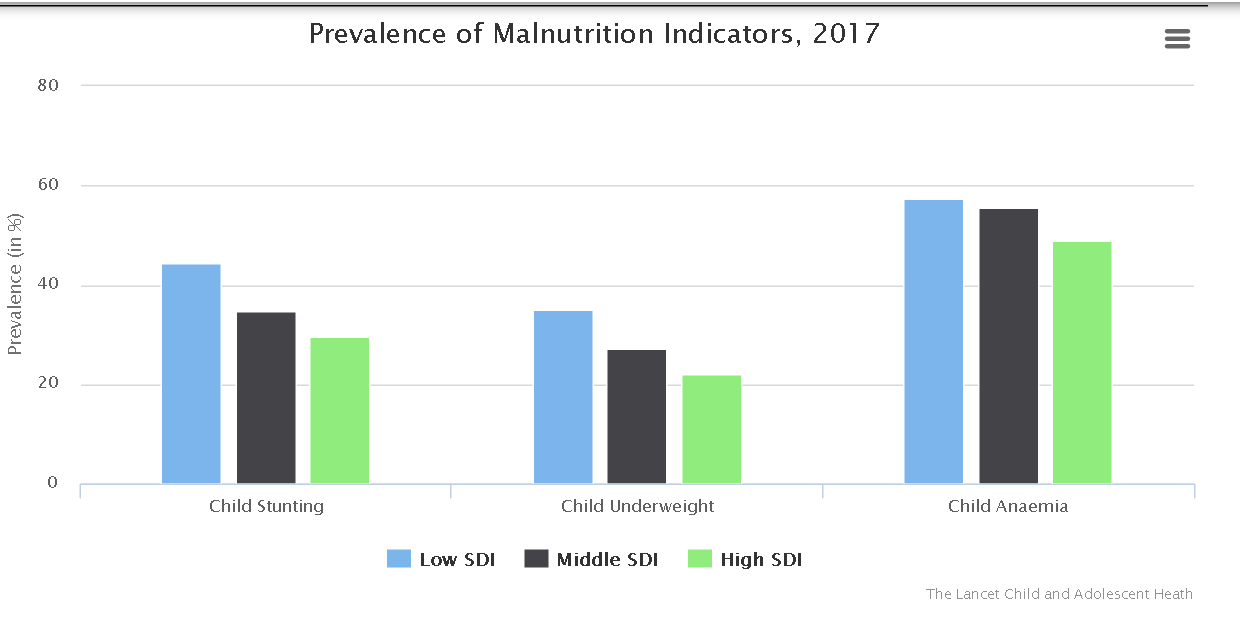The study analysed the prevalence of various malnutrition indicators for the states in various Socio-demographic Index (SDI) groups, and projected the numbers upto 2030 on the basis of the 1990-2017 trends

At its current rate of progress, the National Nutrition Mission (NNM) cannot meet its 2022 targets to reduce malnutrition in India, according to a study published in The Lancet Child and Adolescent Health. According to the study, this is despite the reduction in malnutrition that has been achieved by India in 27 years upto 2017.
The NNM or Poshan Abhiyan, that has been described by the government as ‘PM’s overarching scheme for holistic nourishment’, targeted an annual reduction of two percentage points in the prevalence of low birthweight and child underweight, a 25% fall in the prevalence of child stunting and a three-percentage-point annual decline in the prevalence of anaemia among women and children under five years of age.
The global targets set by World Health Organisation (WHO) and United Nations Children’s Fund (UNICEF), which are supposed to be achieved by 2030 are 30% reduction in prevalence of low birthweight, 50% reduction in the number of children younger than 5 years of age who are stunted from 2012 to 2030, reduction in prevalence of child wasting to 3%. The targets also include reduction in prevalence of anaemia in women between 15 and 49 years of age from 2012 to 2030, increase in prevalence of exclusive breastfeeding in the first 6 months to at least 70%, and reduction in prevalence of child overweight to less than 3%.
Findings of the study
The study analysed the prevalence of various malnutrition indicators for the states in various Socio-demographic Index (SDI) groups, and projected the numbers upto 2030 on the basis of the 1990-2017 trends to compare the current situation with the NNM 2022, and WHO and UNICEF 2030 targets.

The study found that malnutrition was the predominant risk factor for death in children younger than five years of age in every state of India in 2017, accounting for 68.2% of the total under-five deaths, and the leading risk factor for all ages, responsible for 17.3% of the total disability-adjusted life years (DALYs). It stated, “The malnutrition DALY rate was much higher in the low SDI than in the middle SDI and high SDI state groups. This rate varied 6.8 times between the states in 2017, and was highest in the states of Uttar Pradesh, Bihar, Assam, and Rajasthan.”
According to the study, the prevalence of low birthweight in India in 2017 was 21.4%, child stunting was 39.3%, child wasting was 15.7%, and child underweight was 32.7%. Apart from that, anaemia in children under five years of age was a shocking 59.7%, and prevalence of anaemia in women between 15 and 49 years of age was 54.4%. The prevalence of exclusive breastfeeding was 53.3%, and for child overweight was 11.5%.

The study said, “If the trends estimated up to 2017 for the indicators in the NNM 2022 continue in India, there would be 8.9% excess prevalence for low birthweight, 9.6% for stunting, 4.8% for underweight, 11.7% for anaemia in children, and 13.8% for anaemia in women relative to the 2022 targets.” It added, “For the additional indicators in the WHO and UNICEF 2030 targets, the trends up to 2017 would lead to 10.4% excess prevalence for wasting, 14.5% excess prevalence for overweight, and 10.7% less exclusive breastfeeding in 2030. The prevalence of malnutrition indicators, their rates of improvement, and the gaps between projected prevalence and targets vary substantially between the states.”

It said that substantial improvements across the malnutrition indicators in the states of India would require an integrated nutrition policy to effectively address the broader determinants of undernutrition across the life cycle. It said, “These improvements include providing clean drinking water, reducing rates of open defecation, improving women’s status, enhancing agricultural productivity and food security, promoting nutrition sensitive agriculture, coupled with harmonisation of efforts across ministries and sectors, political will and good governance, and strategic investments in a multisectoral approach.”




